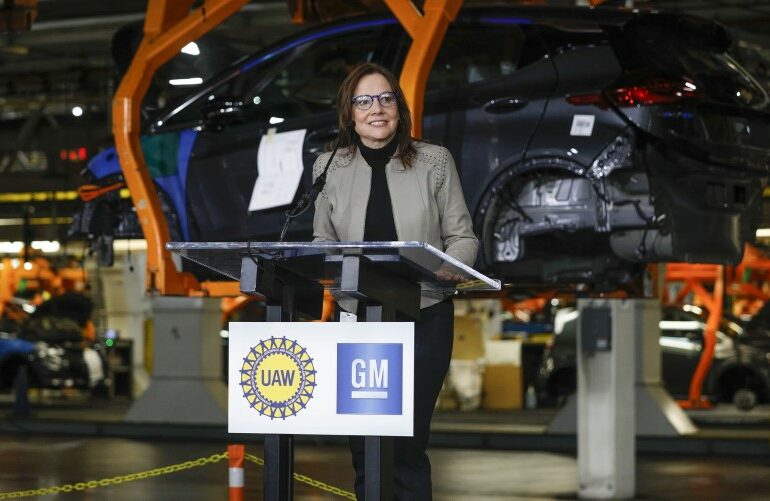General Motors on Wednesday reported fourth-quarter earnings that easily beat Wall Street expectations, but the company warned that a global semiconductor chip shortage could cut its earnings by $2 billion this year.
Automakers and parts suppliers began warning of the shortage late last year after demand for vehicles rebounded more strongly than expected following a two-month shutdown of production plants due to the coronavirus pandemic. GM has already temporarily closed car and crossover plants in Kansas, Canada and Mexico through mid-March due to the shortage. It also has cut production in South Korea.
CEO Mary Barra said GM does not expect to lose any production this year of its highly profitable full-size pickup trucks and SUVs due to the chip shortage.
“It’s still a bit fluid, but our current outlook is that we’re going to be able meet the production schedules we had for the year,” she said during a post-earnings media call.
Barra added that GM will likely need to partially build some models without the parts and complete assembly later. She declined to estimate how many vehicles would be affected.
GM said the shortage would cost it $1.5 billion to $2 billion. GM’s crosstown rival, Ford Motor, said last week the shortage could lower its earnings by $1 billion to $2.5 billion this year. Ford cut production of its profit-critical F-150 pickup this week due to the shortage.
GM’s shares fell by 1.3% in premarket trading.
Here’s what GM reported versus what Wall Street expected, based on average analysts estimates compiled by Refinitiv.
- Adjusted earnings per share: $1.93 vs. $1.64 expected, based on average analysts’ estimates compiled by Refinitiv.
- Revenue: $37.5 billion vs. $36.12 billion expected.
The company said it expects to earn $10 billion to $11 billion, or $4.50 to $5.25 per share, in adjusted pretax profits this year. It projects adjusted free cash flow of $1 billion to $2 billion for its automotive division in 2021. The forecasts factor in the potential impact of the chip shortage, including a hit of $1.5 billion to $2.5 billion to its free cash flow.
GM’s fourth-quarter earnings easily beat results from a year earlier, which were negatively impacted by a U.S. labor strike that shut down vehicle production during the fourth quarter of 2019.
On an unadjusted basis, net income was $2.85 billion for the fourth quarter compared with a loss of $194 million. The automaker reported pretax adjusted earnings of $3.7 billion for the fourth quarter, up from $105 million a year earlier.
The automaker reported pretax adjusted earnings of $5.3 billion, or $2.83 earnings per share, for the third quarter, while saying the fourth quarter would be weaker due to seasonality.
The company expects to spend $9 billion to $10 billion in 2021. That includes plans to accelerate its all-electric and autonomous vehicle development and rollouts as well as deferred spending from last year due to the pandemic. GM previously said its annual capital expenditure costs would exceed $7 billion through at least 2023.
“We are investing in the business,” Barra said. “We see tremendous growth opportunities and we’re also accelerating EVs; $7 billion alone of the $9-$10 billion is focused on EV/AV. So we see a tremendous opportunity there.”














